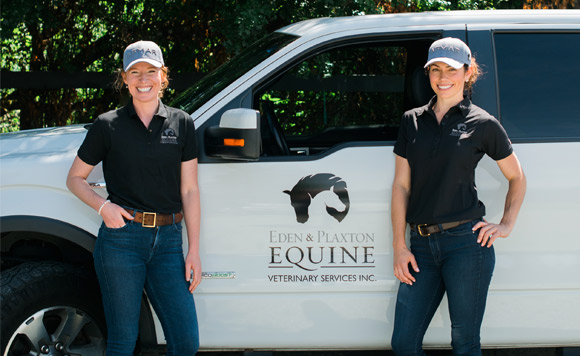by Cassidy Nunn
Horses, just like any other domesticated animal, require regular health care check-ups. I recently sat down with the team of equine veterinarians, Dr. Melissa Eden and Dr. Andrea Plaxton of Eden & Plaxton Equine Veterinary Services. The two met while attending the Western College of Veterinary Medicine in Saskatoon and in August 2019 joined partnership to service the greater Victoria region. Theirs is an ambulatory practice where “we come to the farm,” says Dr. Eden, and this often involves after-hours emergency calls, which can range from lacerations, eye issues, acute lameness, foaling and colic.
“We try to balance our lifestyle by sharing emergency call times,” says Dr. Plaxton.
Equine veterinarians are often called out for cases of colic, which is severe abdominal pain that can be caused by a range of factors from a blockage in the intestinal tract to a twist of the intestine. In more serious cases, the horse may require surgery and for that, the horse will have to be transported to a surgical clinic.
Horses require an annual examination to check their teeth, give yearly vaccinations and assess the horse’s overall health, diet and soundness. The soundness exam is to “make sure they have an even, symmetrical gait,” says Dr. Plaxton, and that the horse is “moving pain free,” says Dr. Eden. This usually requires the horse to be trotted on a hard and soft surface to observe their gait and movement.
Equine veterinarians perform many different procedures including scoping horses for ulcers, taking blood work to check for any deficiencies or metabolic issues, and the breeding of mares which is done more and more with artificial insemination these days.
Horses’ teeth never stop growing and in the wild, when they’re grazing for approximately 20 hours each day, the teeth will naturally wear down. The domesticated horse, however, is often not able to graze for that many hours a day and their diet consists of grain and hay versus grasses. The horse will consume the hay in larger mouthfuls and won’t chew evenly so over time, the teeth can form sharp points which will need to be filed down by a vet. The procedure, though painless, can look quite intimidating; the horse is generally sedated, then a large metal contraption called a speculum is used to hold the horse’s mouth open while the vet files the sharp points down with a tool called a power float.
The old saying “no hoof, no horse,” still rings true. Just as our nails continue to grow and require frequent trimming, so too do domestic horses’ hooves. In the wild they’d be moving enough over rough terrain to naturally keep their hooves at a shorter length, but in a domesticated setting, the hoof continues to grow and requires maintenance. A farrier, who used to be more commonly referred to as a blacksmith, is the practitioner who trims horses’ hooves and will build and attach horseshoes if the horse requires them. Rob Young has been operating his business, Rob Young Farrier Service, for the past 12 years. He is accustomed to working alongside veterinarians quite regularly. “We collaborate and come up with the best solution for each individual horse,” he says. “It’s very important for the owner, veterinarian and farrier to all work together for the health of the animal,” says Rob. The veterinarians will often use a digital X-ray to assess the hoof before the farrier trims it, and then they’ll X-ray after the trim to check for alignment issues.
Some horses require horseshoes while others are fine to stay “barefoot.” “Breeding, stabling, workload, overall health and environment,” says Rob, “are all factors as to whether a horse will need shoes.” Most domesticated horses require a trimming or shoeing rotation of every four to eight weeks.
It takes a dedicated team to keep our horses happy and healthy and with technological and scientific advancements, horse owners have never had so many amazing options to keep our equine partners as “healthy as a horse.”
Photo by Nunn Other Photography.




